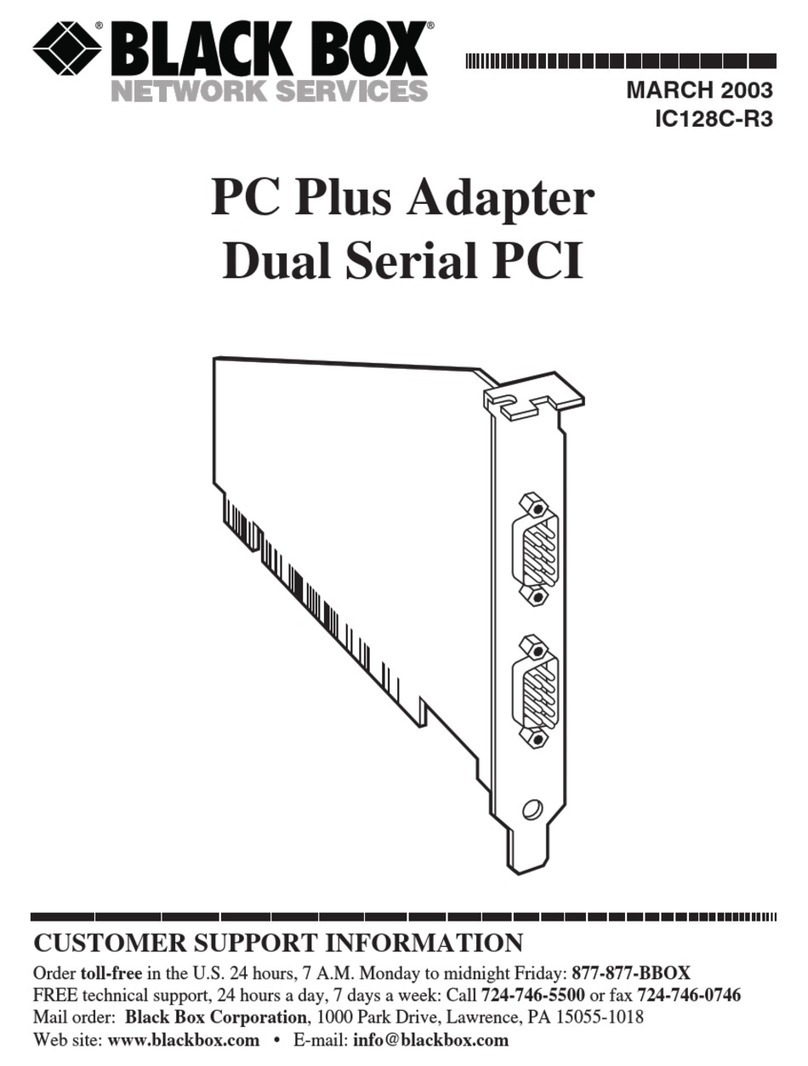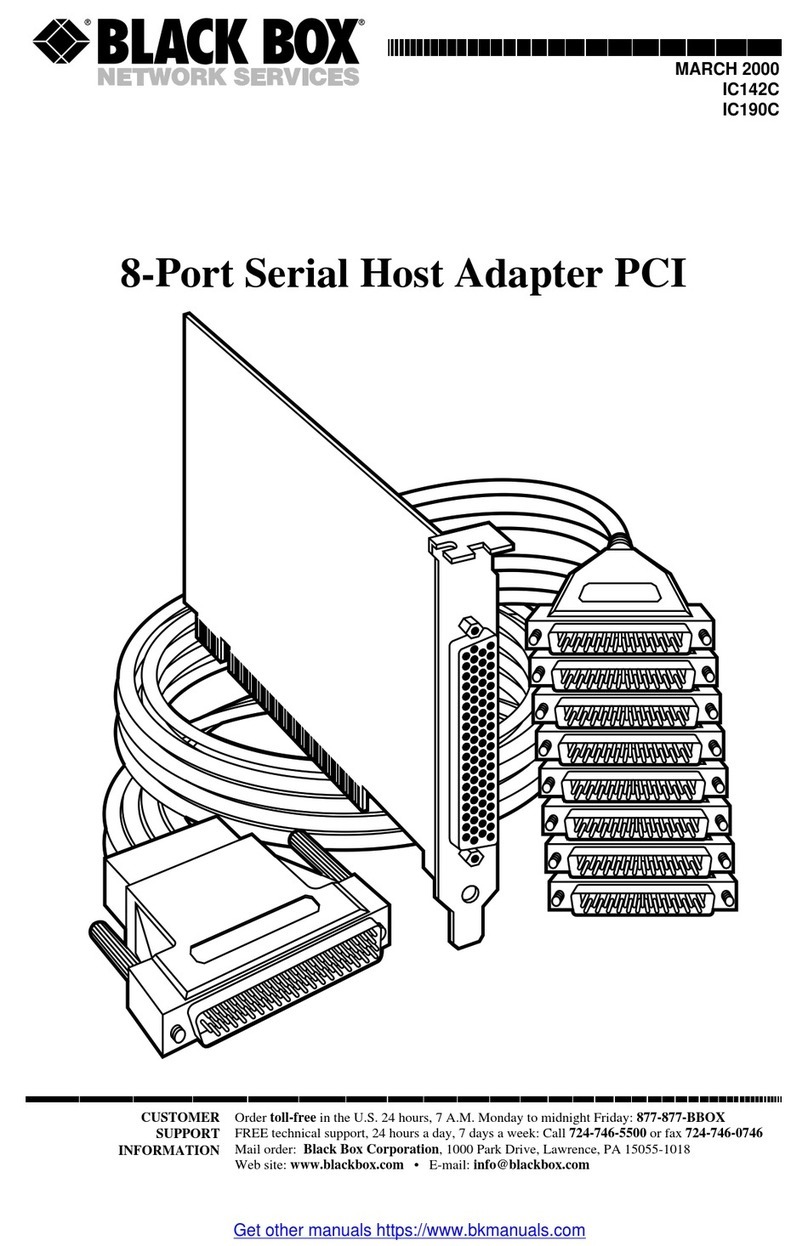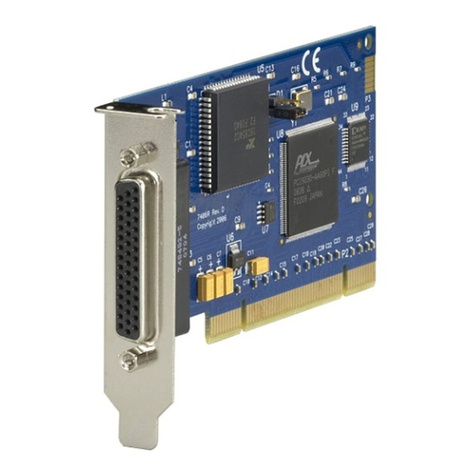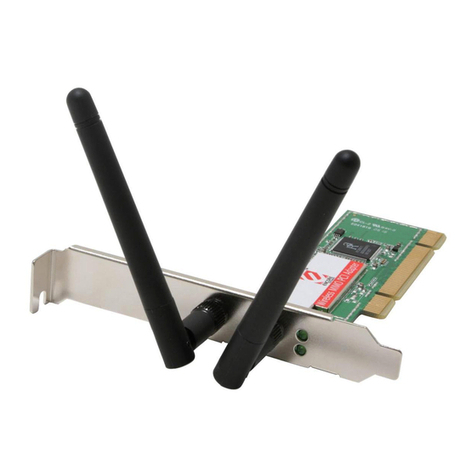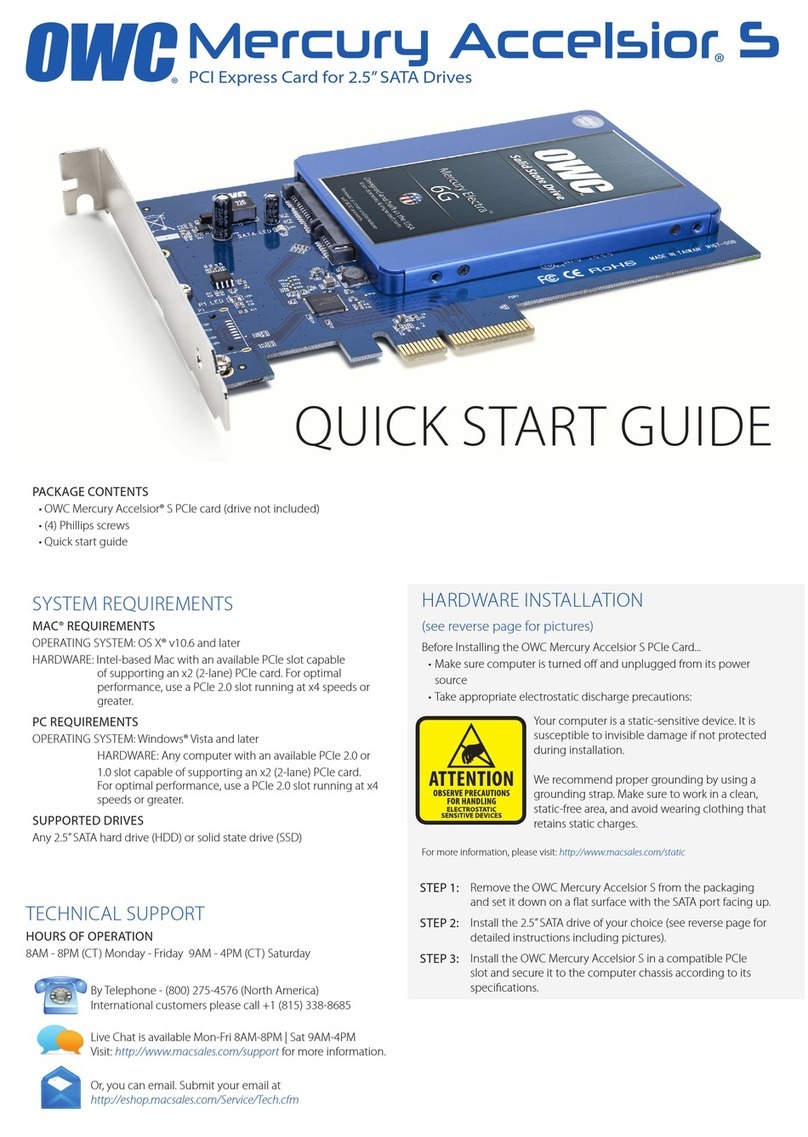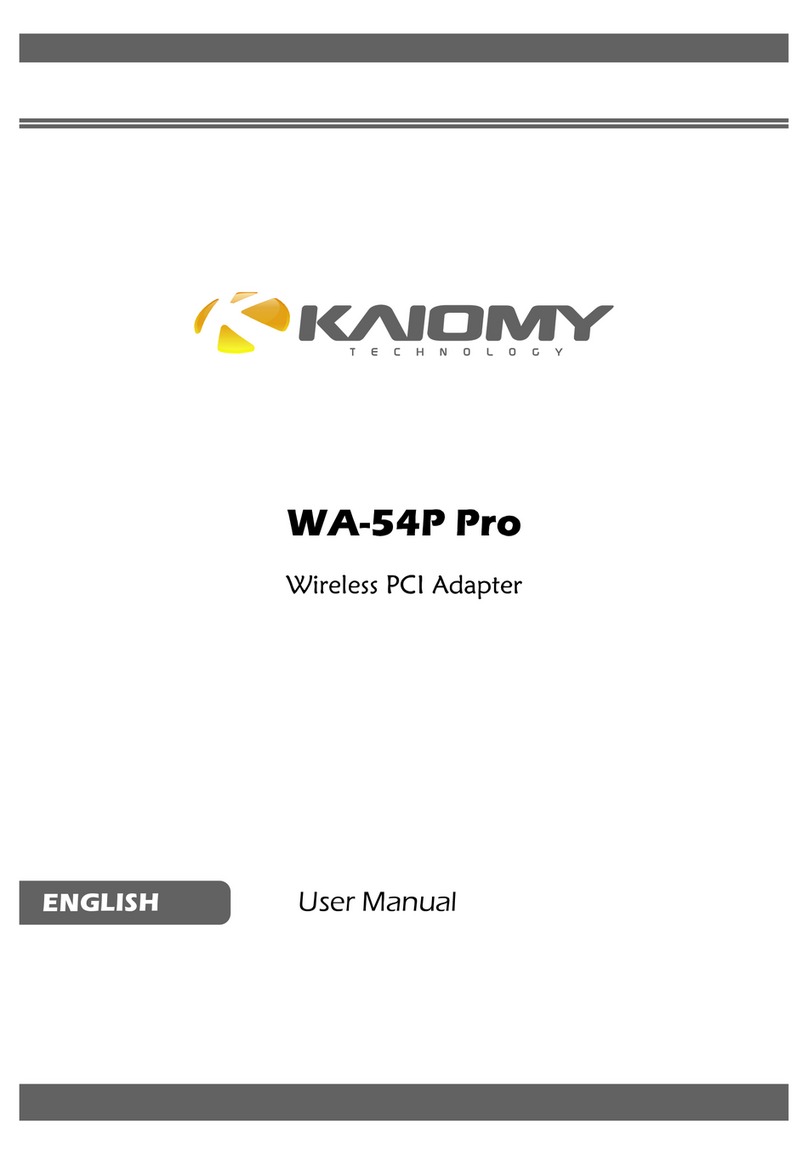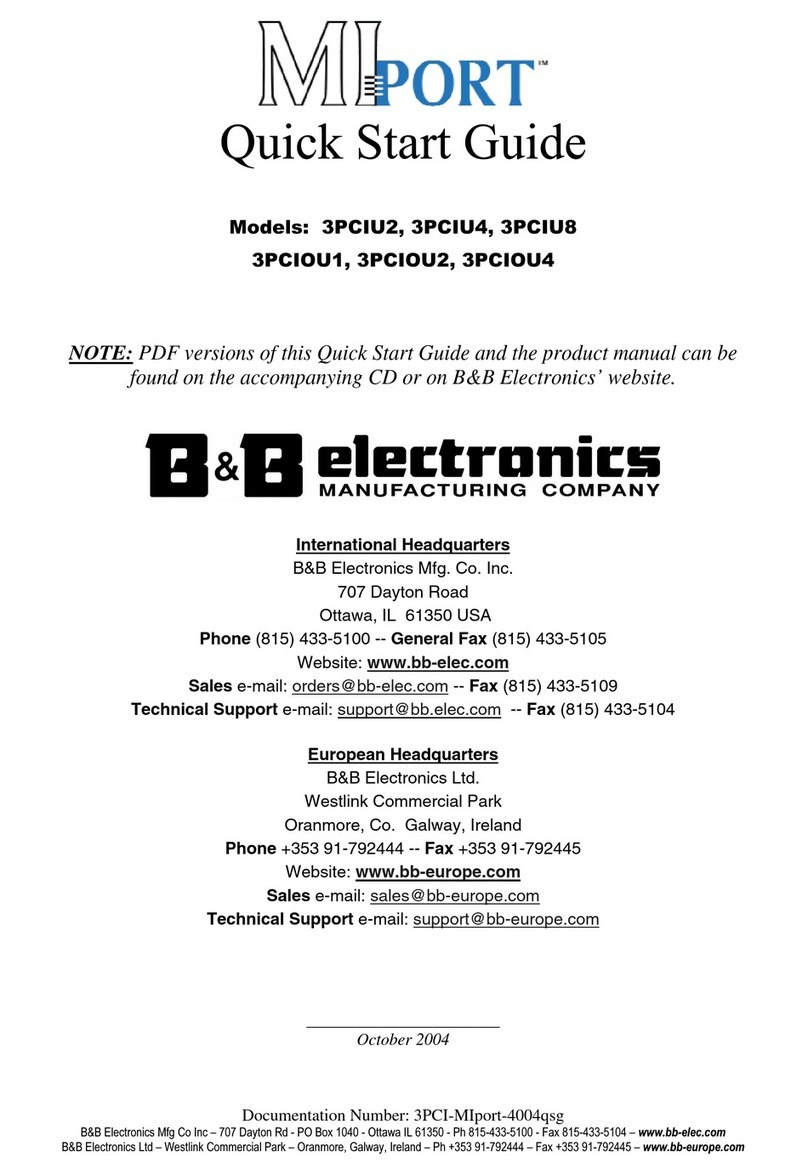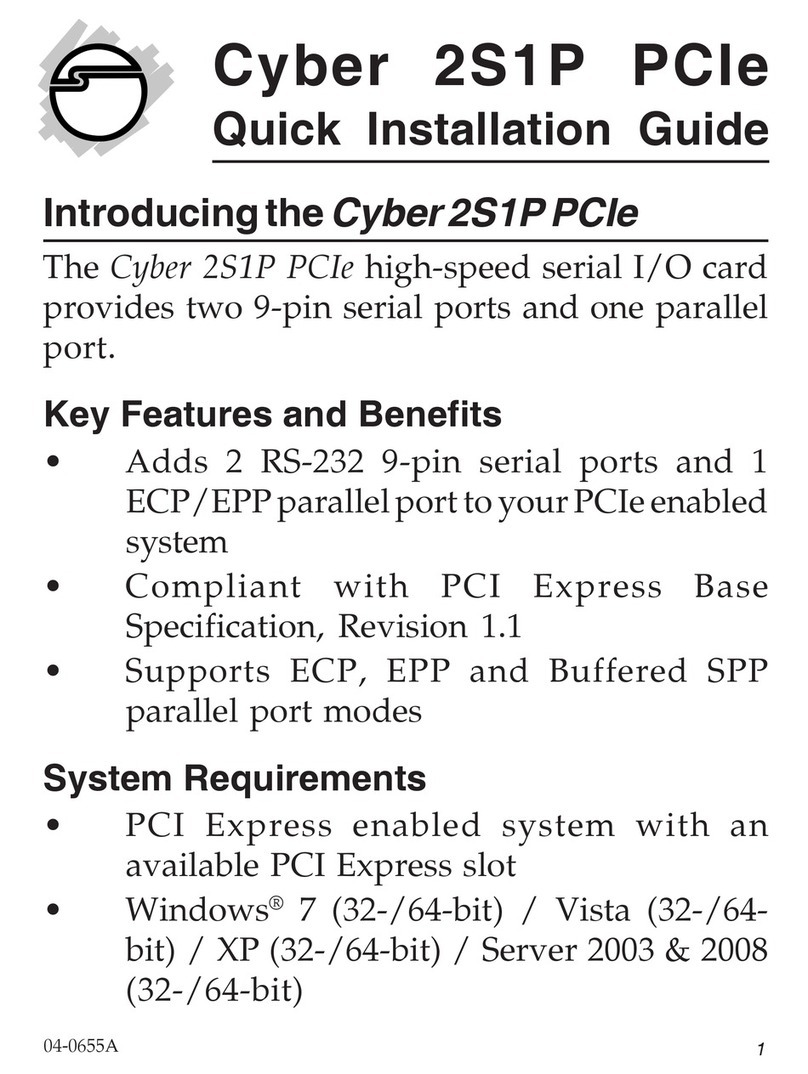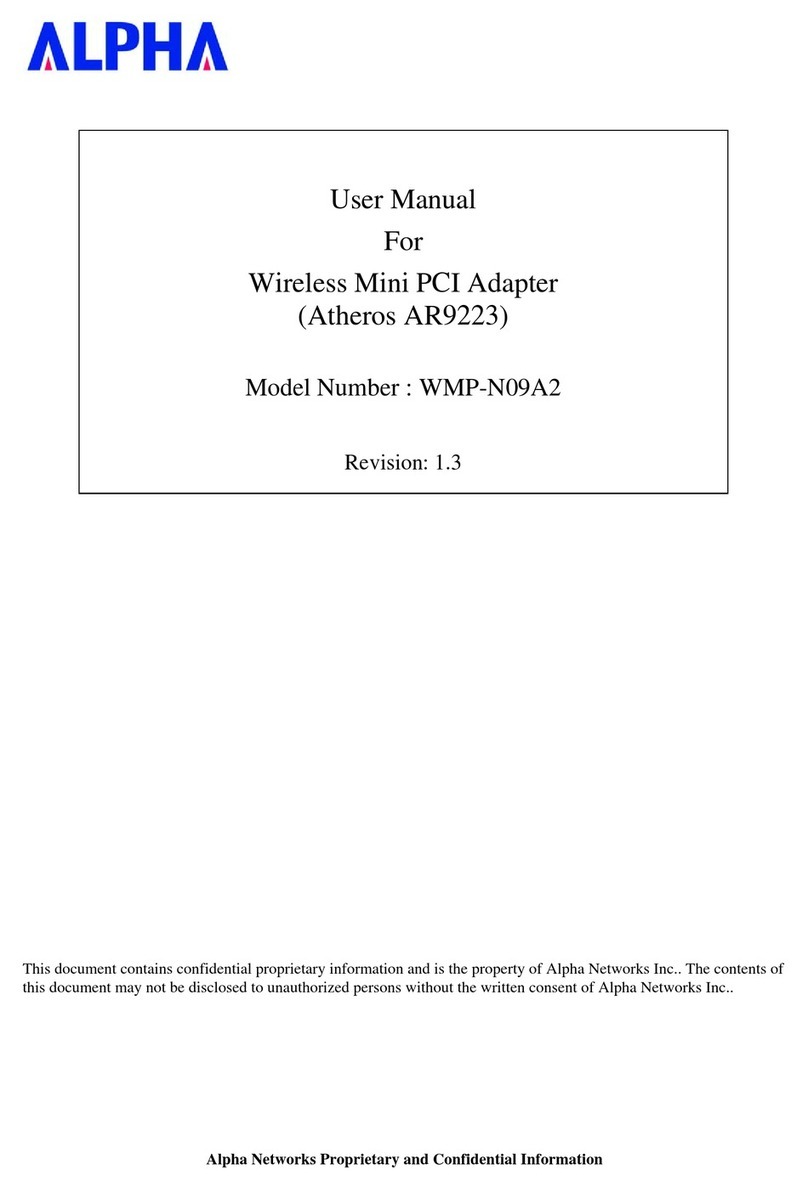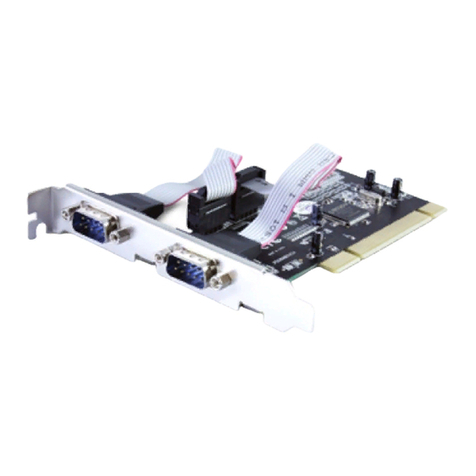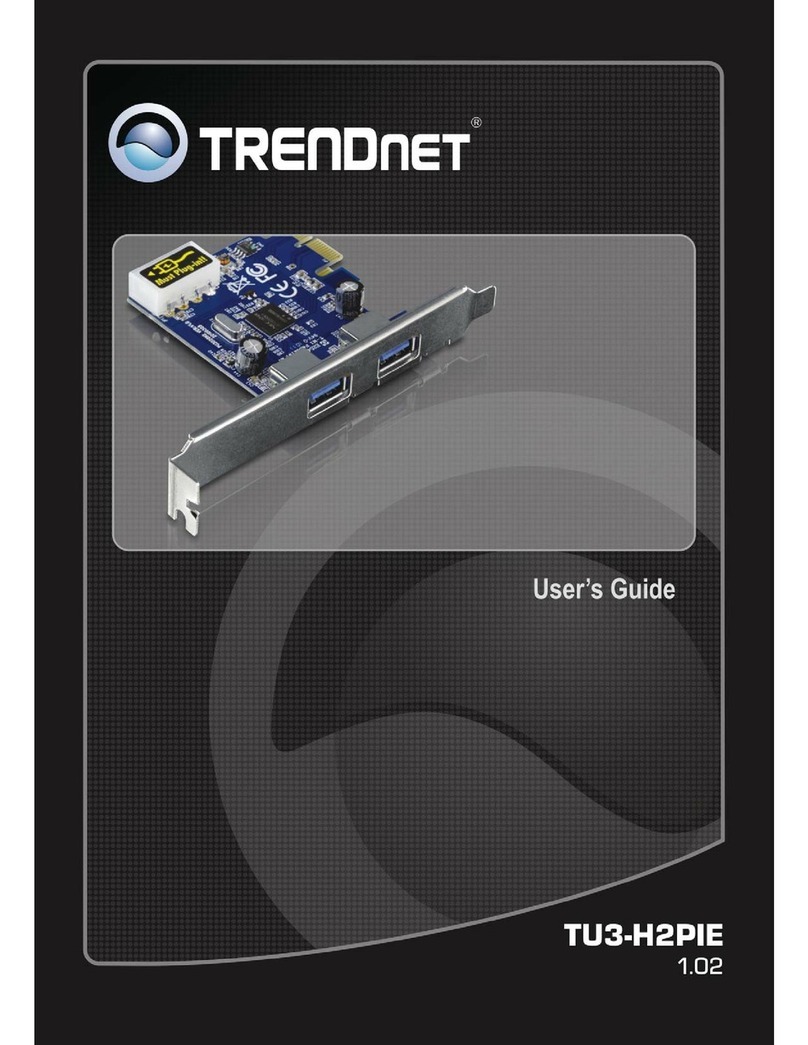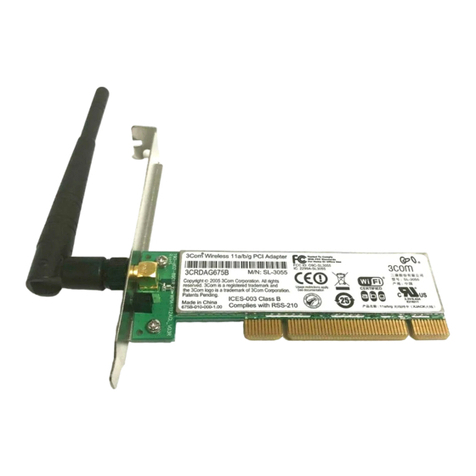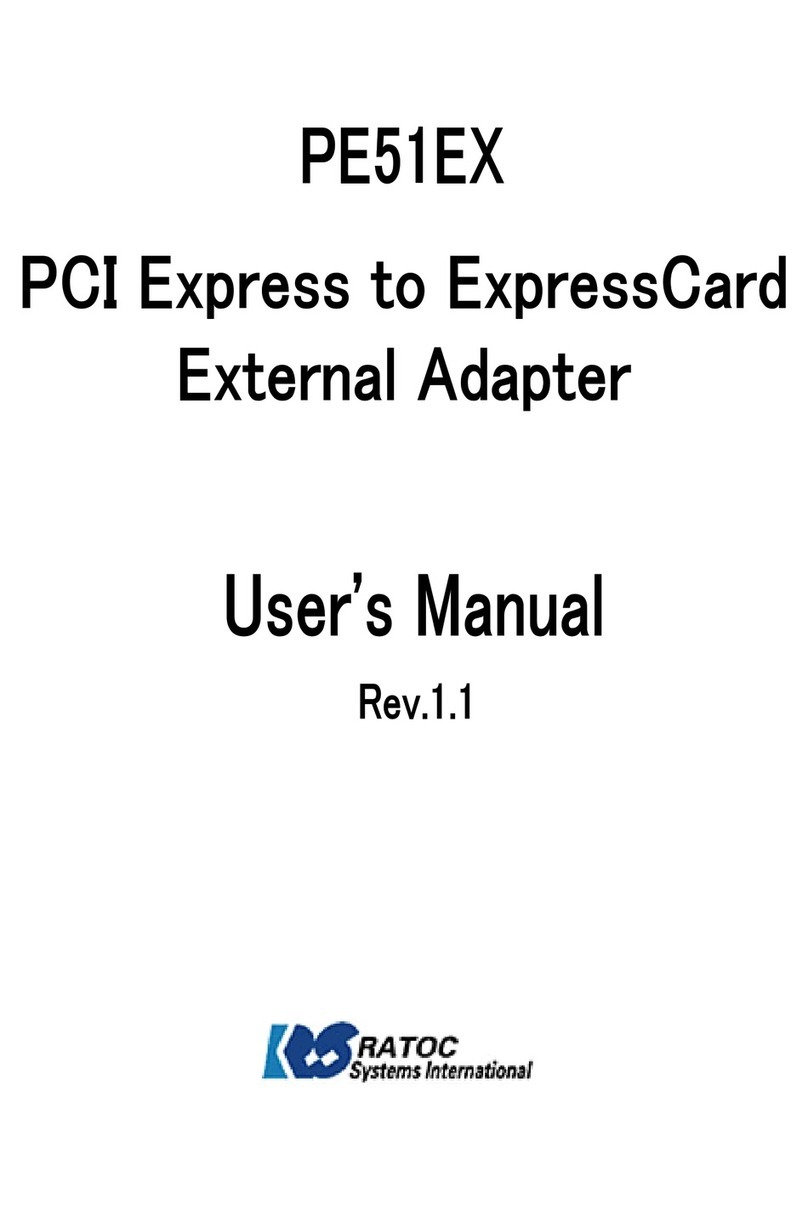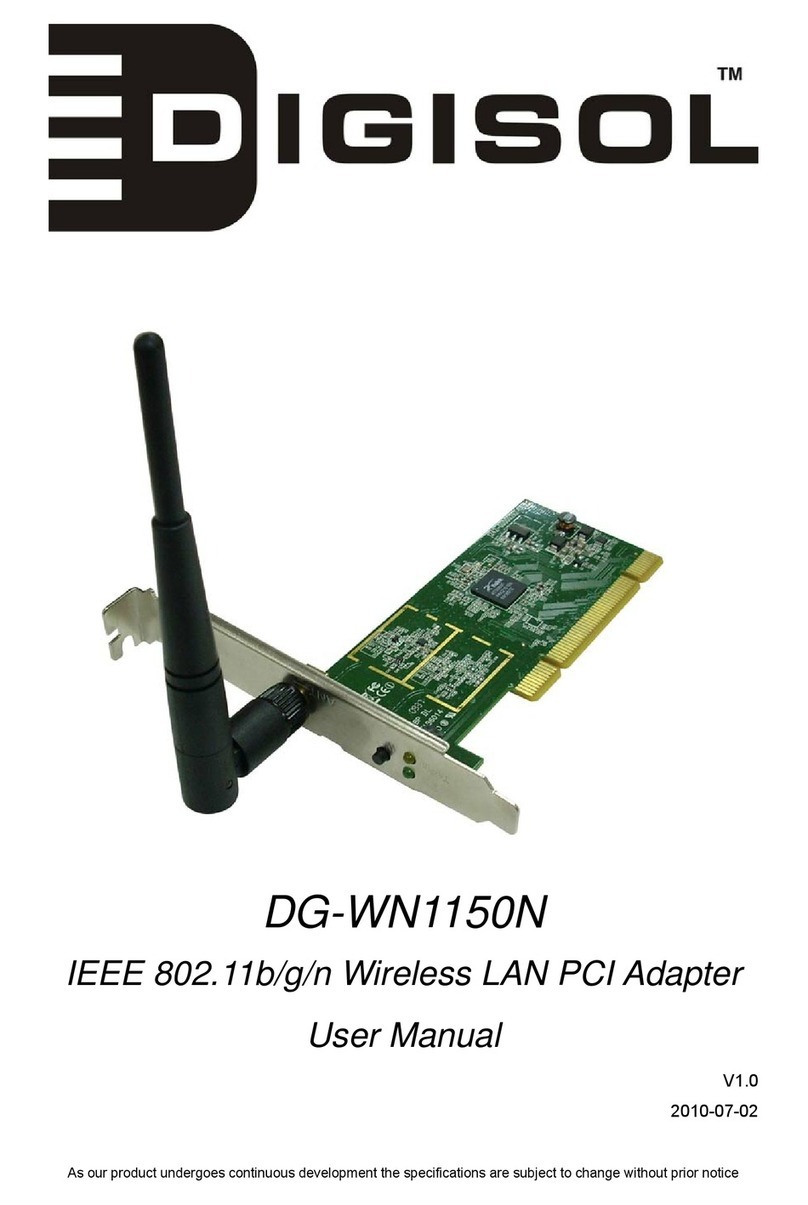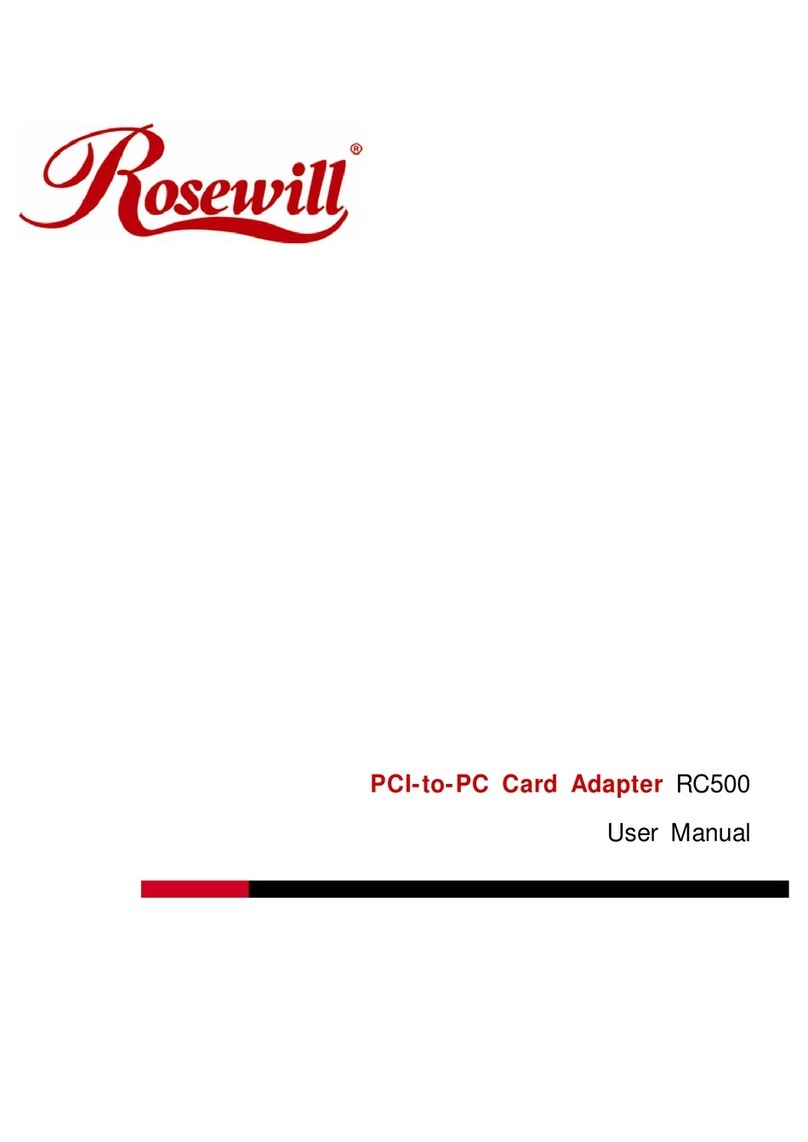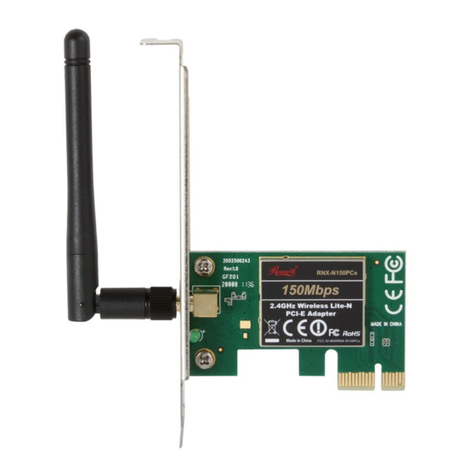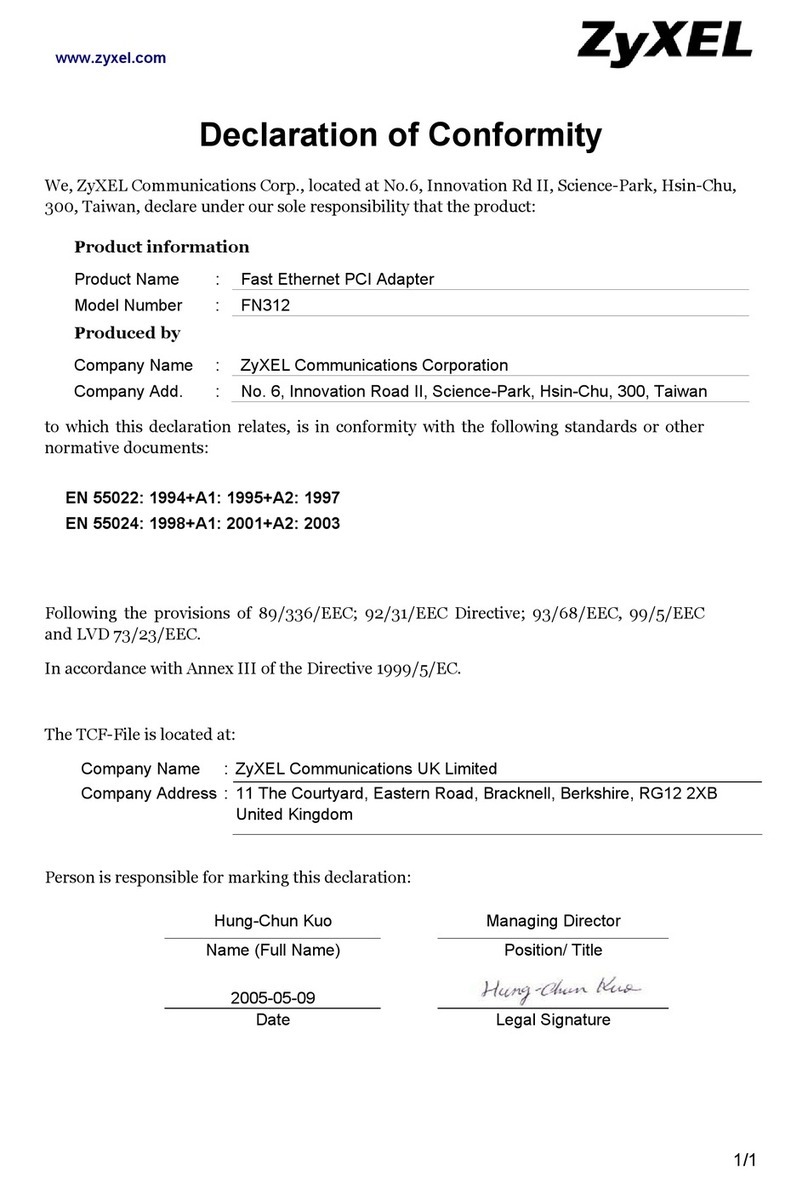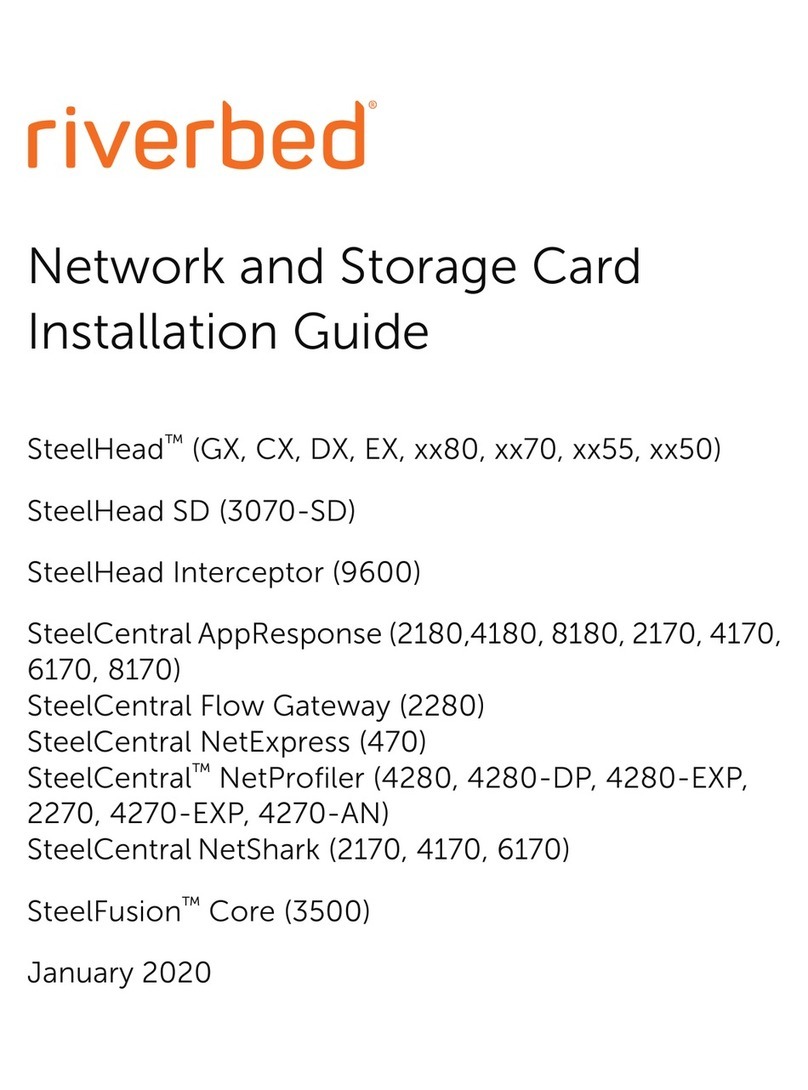Black Box IC906C User manual

CUSTOMER
SUPPORT
INFORMATION
Order toll-free in the U.S. 24 hours, 7 A.M. Monday to midnight Friday: 877-877-BBOX
FREE technical support, 24 hours a day, 7 days a week: Call 724-746-5500 or fax 724-746-0746
Mail order: Black Box Corporation, 1000 Park Drive, Lawrence, PA 15055-1018
JANUARY 2005
IC906C
Digital I/O Card–16

1
FCC AND IC RFI STATEMENTS
FEDERAL COMMUNICATIONS COMMISSION
AND
INDUSTRY CANADA
RADIO FREQUENCY INTERFERENCE STATEMENTS
This equipment generates, uses, and can radiate radio frequency energy and if not
installed and used properly, that is, in strict accordance with the manufacturer’s
instructions, may cause interference to radio communication. It has been tested
and found to comply with the limits for a Class A computing device in accordance
with the specifications in Subpart B of Part 15 of FCC rules, which are designed to
provide reasonable protection against such interference when the equipment is
operated in a commercial environment. Operation of this equipment in a
residential area is likely to cause interference, in which case the user at his own
expense will be required to take whatever measures may be necessary to correct the
interference.
Changes or modifications not expressly approved by the party responsible for
compliance could void the user’s authority to operate the equipment.
This digital apparatus does not exceed the Class A limits for radio noise emission from digital
apparatus set out in the Radio Interference Regulation of Industry Canada.
Le présent appareil numérique n’émet pas de bruits radioélectriques dépassant les limites
applicables aux appareils numériques de la classe A prescrites dans le Règlement sur le
brouillage radioélectrique publié par Industrie Canada.

2
DIGITAL I/O CARD–16
CE Compliance
Products bearing the CE label fulfill the requirements of the EMC directive
(89/336/EEC) and of the low-voltage directive (73/23/EEC) issued by the
European Commission.
To obey these directives, the following European standards must be met:
•EN55022 Class A — “Limits and methods of measurement of radio
interference characteristics of information technology equipment.”
•EN50082-1 — “Electromagnetic compatibility—Generic immunity standard.”
• Part 1: Residential, commercial, and light industry.
•EN60950 (IEC950) — “Safety of information technology equipment, including
electrical business equipment.”
WARNING
This is a Class A Product. In a domestic environment, this product may
cause radio interference in which case you may be required to take
adequate measures.
Always use cabling provided with this product if possible. If no cable is provided or
if an alternate cable is required, use high-quality shielded cabling to maintain
compliance with FCC/EMC directives.

3
NOM STATEMENT
NORMAS OFICIALES MEXICANAS (NOM)
ELECTRICAL SAFETY STATEMENT
INSTRUCCIONES DE SEGURIDAD
1. Todas las instrucciones de seguridad y operación deberán ser leídas antes de
que el aparato eléctrico sea operado.
2. Las instrucciones de seguridad y operación deberán ser guardadas para
referencia futura.
3. Todas las advertencias en el aparato eléctrico y en sus instrucciones de
operación deben ser respetadas.
4. Todas las instrucciones de operación y uso deben ser seguidas.
5. El aparato eléctrico no deberá ser usado cerca del agua—por ejemplo, cerca
de la tina de baño, lavabo, sótano mojado o cerca de una alberca, etc..
6. El aparato eléctrico debe ser usado únicamente con carritos o pedestales que
sean recomendados por el fabricante.
7. El aparato eléctrico debe ser montado a la pared o al techo sólo como sea
recomendado por el fabricante.
8. Servicio—El usuario no debe intentar dar servicio al equipo eléctrico más allá
a lo descrito en las instrucciones de operación. Todo otro servicio deberá ser
referido a personal de servicio calificado.
9. El aparato eléctrico debe ser situado de tal manera que su posición no
interfiera su uso. La colocación del aparato eléctrico sobre una cama, sofá,
alfombra o superficie similar puede bloquea la ventilación, no se debe colocar
en libreros o gabinetes que impidan el flujo de aire por los orificios de
ventilación.
10. El equipo eléctrico deber ser situado fuera del alcance de fuentes de calor
como radiadores, registros de calor, estufas u otros aparatos (incluyendo
amplificadores) que producen calor.
11. El aparato eléctrico deberá ser connectado a una fuente de poder sólo del
tipo descrito en el instructivo de operación, o como se indique en el aparato.

4
DIGITAL I/O CARD–16
12. Precaución debe ser tomada de tal manera que la tierra fisica y la polarización
del equipo no sea eliminada.
13. Los cables de la fuente de poder deben ser guiados de tal manera que no
sean pisados ni pellizcados por objetos colocados sobre o contra ellos,
poniendo particular atención a los contactos y receptáculos donde salen del
aparato.
14. El equipo eléctrico debe ser limpiado únicamente de acuerdo a las
recomendaciones del fabricante.
15. En caso de existir, una antena externa deberá ser localizada lejos de las lineas
de energia.
16. El cable de corriente deberá ser desconectado del cuando el equipo no sea
usado por un largo periodo de tiempo.
17. Cuidado debe ser tomado de tal manera que objectos liquidos no sean
derramados sobre la cubierta u orificios de ventilación.
18. Servicio por personal calificado deberá ser provisto cuando:
A: El cable de poder o el contacto ha sido dañado; u
B: Objectos han caído o líquido ha sido derramado dentro del aparato; o
C: El aparato ha sido expuesto a la lluvia; o
D: El aparato parece no operar normalmente o muestra un cambio en su
desempeño; o
E: El aparato ha sido tirado o su cubierta ha sido dañada.

5
TRADEMARKS USED IN THIS MANUAL
TRADEMARKS USED IN THIS MANUAL
Linux is a registered trademark of Linus Torvalds.
Windows and Windows NT are either registered trademarks or trademarks of
Microsoft Corporation in the United States and/or other countries.
Any other trademarks mentioned in this manual are acknowledged to be the property of the
trademark owners.

6
DIGITAL I/O CARD–16
Contents
Chapter Page
1. Specifications. . . . . . . . . . . . . . . . . . . . . . . . . . . . . . . . . . . . . . . . . . . . . . . . . . . . 7
2. Introduction . . . . . . . . . . . . . . . . . . . . . . . . . . . . . . . . . . . . . . . . . . . . . . . . . . . . 8
2.1 Overview . . . . . . . . . . . . . . . . . . . . . . . . . . . . . . . . . . . . . . . . . . . . . . . . . . . . 8
2.2 What’s Included. . . . . . . . . . . . . . . . . . . . . . . . . . . . . . . . . . . . . . . . . . . . . . 8
2.3 Technical Description. . . . . . . . . . . . . . . . . . . . . . . . . . . . . . . . . . . . . . . . . 8
2.3.1 Features . . . . . . . . . . . . . . . . . . . . . . . . . . . . . . . . . . . . . . . . . . . . . . 9
2.3.2 Input Ports . . . . . . . . . . . . . . . . . . . . . . . . . . . . . . . . . . . . . . . . . . . 9
2.3.3 Output Ports (Reed Relay) . . . . . . . . . . . . . . . . . . . . . . . . . . . . . 11
2.3.4 Software. . . . . . . . . . . . . . . . . . . . . . . . . . . . . . . . . . . . . . . . . . . . . 12
3. Card Setup . . . . . . . . . . . . . . . . . . . . . . . . . . . . . . . . . . . . . . . . . . . . . . . . . . . . . . 13
4. Installation . . . . . . . . . . . . . . . . . . . . . . . . . . . . . . . . . . . . . . . . . . . . . . . . . . . . . . 14
Appendix A. Troubleshooting. . . . . . . . . . . . . . . . . . . . . . . . . . . . . . . . . . . . . . . . . 15
A.1 Calling Black Box . . . . . . . . . . . . . . . . . . . . . . . . . . . . . . . . . . . . . . . . . . . 15
A.2 Shipping and Packaging . . . . . . . . . . . . . . . . . . . . . . . . . . . . . . . . . . . . . . 16
Appendix B. Block Diagram . . . . . . . . . . . . . . . . . . . . . . . . . . . . . . . . . . . . . . . . . . 17

7
CHAPTER 1: Specifications
1. Specifications
Compliance: CE approval; FCC Part A, Class A
Channels: 16 input/16 output
Input Range: 3 to 12 VDC
Input Isolation: 400 V optical
Output Relay: 200 million closures
Throughput: 600 Hz
Relay Contact Power Ratings: 10 watts maximum
Relay Contact Voltage: 100 volts DC or AC maximum
Relay Contact Current: 0.5 amps DC or AC RMS maximum
Relay Contact Resistance:Initial: 0.15 ohms
Relay Rated Life:Low load: 200 million closures;
Maximum load: 100 million closures
Relay Contact Speed:Operate: 0.5 mS; Release: 0.5 mS; Bounce: 0.5 mS
Relay Maximum Operating Speed: 600 Hz
MTBF: Greater than 150,000 hours, excluding relays; relay life expectancy depends
on actual application
Connectors: (1) DB78 female on card; (1) DB37 female and (1) DB37 male on “Y”
cable
Temperature Tolerance:Operating: 32 to 122°F (0 to 50°C);
Storage: -4 to +158°F (-20 to +70°C)
Humidity Range: 10 to 90% noncondensing
Power: From the bus
Power Consumption:Supply line: +12 VDC, +5 VDC; Rating: 450 mA
Size:Including goldfingers: 4.2"H x 6"W (10.7 x 15.2 cm);
Excluding goldfingers: 3.8"H x 6"W (9.7 x 15.2 cm)

8
DIGITAL I/O CARD–16
2. Introduction
2.1 Overview
The Digital I/O Card–16 provides 16 reed relays that can latch power, data, or
other electronic signals for control applications and 16 optically isolated inputs to
allow monitoring of off-board switch closures, relays, or for any other general-
purpose monitoring needs. The card is PCI 2.1 bus compliant. Addressing, data,
and control signals are TTL compatible.
2.2 What’s Included
The Digital I/O Card–16 is shipped with the following items. If any of these items
are missing or damaged, contact Black Box at 724-746-5500.
• Digital I/O Card–16
• Systems software (on a CD-ROM)
• This users’ manual
2.3 Technical Description
The Digital I/O Card–16 provides four parallel input/output (I/O) ports. The
ports are organized as ports A, B, C, and D. Ports A and B are input ports
interfaced to optically-isolated inputs, while ports C and D are reed relay output
ports. Assuming an I/O address of 300 Hex, Table 2-1 shows the port addresses.
Table 2-1. Port addresses.
Base Address Hex Decimal Mode
Port A Address 300 768 Input Port (Opto-Input)
Port B Address 301 769 Input Port
Port C Address 302 770 Output Port (Reed Relays)
Port D Address 303 771 Output Port

9
CHAPTER 2: Introduction
2.3.1 F
EATURES
• Selectable I/O port addressing from 100H through 3FFH.
• Two sets SPST relays (each set has eight relays).
• Two eight-bit input ports.
• DB37 male connector for relay outputs.
• DB37 female connector for optically isolated inputs.
• Highly reliable 10-VA DIP reed relays used.
• Multiple adapters can reside in same computer.
• All address, data, and control signals are TTL compatible.
2.3.2 I
NPUT
P
ORTS
Ports A and B are 8-bit input ports connected to optically isolated input sensors.
Each sensor can be used to interface a voltage input and then sense whether the
voltage is on or off. Each sensor is isolated (with respect to a common ground)
from every other sensor, and it’s also isolated with respect to the host PC ground.
This means that signals such as low-level AC line voltage, motor servo voltage, and
control relay signals can be “sensed,” or read by the PC, without the risk of damage
due to ground loops or ground faults.
Each sensor input pair has a current-limiting resistor that is used to limit the input
current to the opto-isolator. The opto-isolator has two “back-to-back” diodes
internally. This allows AC or DC signals to be sensed, regardless of polarity. When
the applied voltage is high enough to cause the LED in the opto-isolator to power
on, the output of the opto-isolator goes low (0 volts) and the signal is read as a low
logic level (binary 0) by the PC. When the input signal is too low to power on the
opto-isolator, the output goes high and the port bit is read by the PC as a high
logic level (binary 1).

10
DIGITAL I/O CARD–16
The input impedance of each isolated input is approximately 560 ohms (factory
default). The opto-isolator requires approximately 3 mA to power on. The
maximum input current is 60 mA. You must consider two things when selecting the
input resistor: The first is power-on voltage for the circuit to sense, and second is
the maximum input voltage. Maximum input voltage must not provide too much
power to the input resistor, and it must also not overdrive the opto-isolator input
current specification. The following formulas apply:
Power-on current: 3 mA
Isolator diode drop: 1.1 V
Resistor power max.: 0.25 W
Power-on voltage = diode drop + (turn-on current) x ( resistance)
Or :
1.1 + (.003) x R
Maximum voltage = square root of (0.25 [resistor value])
Table 2-2 shows four common input resistors and the ranges associated with each.
Table 2-2. Input resistor ranges.
Input Resistor Value Power-On Max. Input Range Max. Current
(ohms) (volts) (volts) (mA)
220 1.76 7 27
560 2.8 12 20
1K 4.1 16 15
2.2K 7.7 24 10
The maximum input voltage can be increased by increasing the input resistor
accordingly. Because socketed DIP resistor networks are used, they can easily be
replaced with a different value. This can be done at the factory, if necessary. The
input circuits are not intended for monitoring 120-volt AC circuits. In addition to
being too high a voltage for the circuits, it is dangerous to have that high a voltage
on the card.
Table 2-3 lists the input ports pin assignments.

11
CHAPTER 2: Introduction
Table 2-3. Pin assignments for sensor input ports
(DB37 female labeled as input).
Port A Bit P1 Pin Port B Bit P1 Pin
0 18, 37 0 10, 29
1 17, 36 1 9, 28
2 16, 35 2 8, 27
3 15, 34 3 7, 26
4 14, 33 4 6, 25
5 13, 32 5 5, 24
6 12, 31 6 4, 23
7 11, 30 7 3, 22
Ground 2, 20, 21
+12 volts 19
+5 volts 1
2.3.3 O
UTPUT
P
ORTS
(R
EED
R
ELAY
)
Reed relays provide very-high-quality, long-life, low-current (10-watt maximum),
dry-contact switch closures. Reed relays are not suited for high-current applications
and can be destroyed by inductive load switching (where a spark occurs across the
contacts internally). The relays are normally open, and they close when energized.
Each relay can be individually energized by writing a “1” to the proper port bit.
Table 2-4 shows the output ports’ pin assignments.
Table 2-4. Output ports (reed relay) pin assignments
(DB37 male labeled as output).
Port C Bit Relay P2 Pin Port D Bit Relay P2 Pin
0 K16 2, 20 0 K8 10, 28
1 K15 3, 21 1 K7 11, 29
2 K14 4, 22 2 K6 12, 30
3 K13 5, 23 3 K5 13, 31
4 K12 6, 24 4 K4 14, 32
5 K11 7, 25 5 K3 15, 33
6 K10 8, 26 6 K2 16, 34
7 K9 9, 27 7 K1 17, 35
Ground 18, 36, 37
+5 volts 19
+12 volts 1

12
DIGITAL I/O CARD–16
2.3.4 S
OFTWARE
The Digital I/O Card–16 ships with an I/O suite of Windows®98/Me/XP,
Windows NT®, and Windows 2000 drivers. These drivers provide you with a
consistent and straightforward application program interface (API), allowing the
developer to concentrate on the details of the application as opposed to low-level
driver development. Popular development environments, including Visual C++,
Visual Basic, and Delphi, are supported for application development. I/O includes
a utility for configuring the driver parameters under Windows, further simplifying
installation.
For DOS, QNX, Linux®and other operating systems, please refer to the software
included with your card.
Programming Examples
All examples assume a base address of 300 Hex.
To read inputs at port A :
MOV DX,300H ;Set DX to Port A
IN AL,DX ;Get Input Port Data
NOT AL ;data read is negative
logic
Programming example to set Relay #3 on, write a “1” in bit position D3, to port
address Base+3, or 303 Hex.
MOV DX, 303H ;Set DX to Port D
MOV AL, 00001000B ;Set bit 3 to a ‘1’
OUT DX, AL
Another method that takes into account the read-back capability of the output
ports C and D:
MOV DX,303H ;Set DX To Port D
IN AL,DX ;Get old port setting
NOT AL :Invert bits- see note below
OR AL,00001000B ;OR in bit 3
OUT DX,AL ;Set Bit 3
NOTE
Reading back the ports (C and D) results in the binary complement of
the output.

13
CHAPTER 3: Card Setup
3. Card Setup
Table 3-1 lists the addresses for the card.
Table 3-1. The card’s address assignments.
Address Mode D7 D6 D5 D4 D3 D2 D1 D0
Base+0 RD/WR PAD7 PAD6 PAD5 PAD4 PAD3 PAD2 PAD1 PAD0
Base+1 RD/WR PBD7 PBD6 PBD5 PBD4 PBD3 PBD2 PBD1 PBD0
Base+2 RD/WR PCD7 PCD6 PCD5 PCD4 PCD3 PCD2 PCD1 PCD0
Base+3 RD/WR PDD7 PDD6 PDD5 PDD4 PDD3 PDD2 PDD1 PDD0
Base+4 RD/WR {0} {0} {0} {0} {0} {0} {0} {0}
Base+5 RD/WR IRQEN IRQST {0} {0} {0} {0} 1RC1 1RC0
Base+6 RD only {0} {0} {0} {0} {0} {0} {0} {0}
Base+7 RD only {0} {0} {0} {0} {0} {0} {0} {0}
NOTE
All ports are set to input after reset or power-up. Interrupt source is
Base+0 bit D0. When selecting the Interrupt Mode, always disable
interrupts before changing or setting states. This will help prevent
inadvertent or unexpected interrupts from occurring. When using the
high- and low-level interrupts, a change in state of the input must occur
before the interrupt can be cleared. The device providing the input to
Base+0, bit D0, must do this.
PAD0–7 =Port A (Base+0)
PBD0–7 =Port B (Base+1)
PCD0–7 =Port C (Base+2)
PDD0–7 =Port D (Base+3)
IRC0–1 =Interrupt Mode select (Base+5)
IRC1 IRC0
0 0 low level
0 1 high level
1 0 falling edge
1 1 rising edge
IRQEN =enable interrupts (Base+5)
0=disabled
1=enabled (disabled after reset or power-up)
IRQST =interrupt status (Base+5)
1=interrupt pending (reading the bit clears
interrupt)

14
DIGITAL I/O CARD–16
4. Installation
The Digital I/O Card–16 can be installed in any PC expansion slot. Before you
install the card, make sure you have followed the configuration instructions in
Chapter 3.
To install the card:
1. Turn off all PC power and disconnect the power cord.
2. Remove the cover of the PC case.
3. Locate two available slots and remove the blank metal slot covers.
4. Gently insert the Digital I/O Card–16 into the slot. Make sure the card is
seated properly. Insert the cable bracket into the adjacent slot and screw it in
place.
5. Replace the PC’s cover.
6. Connect the power cord.
Installation is complete.

15
APPENDIX A: Troubleshooting
Appendix A. Troubleshooting
Following these simple steps can eliminate most common problems without the
need to call Technical Support.
1. Install software first. After installing the software, add the hardware. This
places the required installation files in the correct locations.
2. Identify all I/O adapters currently installed in your system. This includes your
onboard serial ports, controller cards, sound cards, etc. The I/O addresses
used by these adapters, as well as the IRQ (if any), should be identified.
3. Make sure that there is no conflict with currently installed adapters. No two
adapters can occupy the same I/O address and may not be allowed to share
IRQs.
4. Make sure the system’s adapter is securely installed in a motherboard slot.
A.1 Calling Black Box
If you determine that your Digital I/O Card–16 is malfunctioning, do not attempt
to alter or repair the unit. It contains no user-serviceable parts. Contact Black Box
at 724-746-5500.
Before you do, make a record of the history of the problem. We will be able to
provide more efficient and accurate assistance if you have a complete description,
including:
• the nature and duration of the problem.
• when the problem occurs.
• the components involved in the problem.
• any particular application that, when used, appears to create the problem or
make it worse.

16
DIGITAL I/O CARD–16
A.2 Shipping and Packaging
If you need to transport or ship your Digital I/O Card–16:
• Package it carefully. We recommend that you use the original container.
• If you are shipping the Digital I/O Card–16 for repair, make sure you include
everything that came in the original package. Before you ship, contact Black
Box to get a Return Authorization (RA) number.

17
APPENDIX B: Block Diagram
Appendix B. Block Diagram
6.0"
3.8"
4.2"
C4C3C2C1
C8C7C6C5
C12C11C10C9
C16C15C14C13
C17
P3
P1
P2
K5 K1
C22
K13 K9
C18
K6 K2
C23
K14 K10
C19
K7 K3
C24
K15 K11
C20
K8 K4
C25
K16 K12
RP3 U1 U2
RP2 U4 U5
U3
RP4
RP1
C27
C26
C32
C35
C34
R1 R2
C21
Y1
C30
U6
U7
R3 R4 C28
R5 R6 R7 C29
C31
C33
C37
C36
C38
F2 F1

1000 Park Drive • Lawrence, PA 15055-1018 • 724-746-5500 • Fax 724-746-0746
© Copyright 2005. Black Box Corporation. All rights reserved.
Table of contents
Other Black Box PCI Card manuals
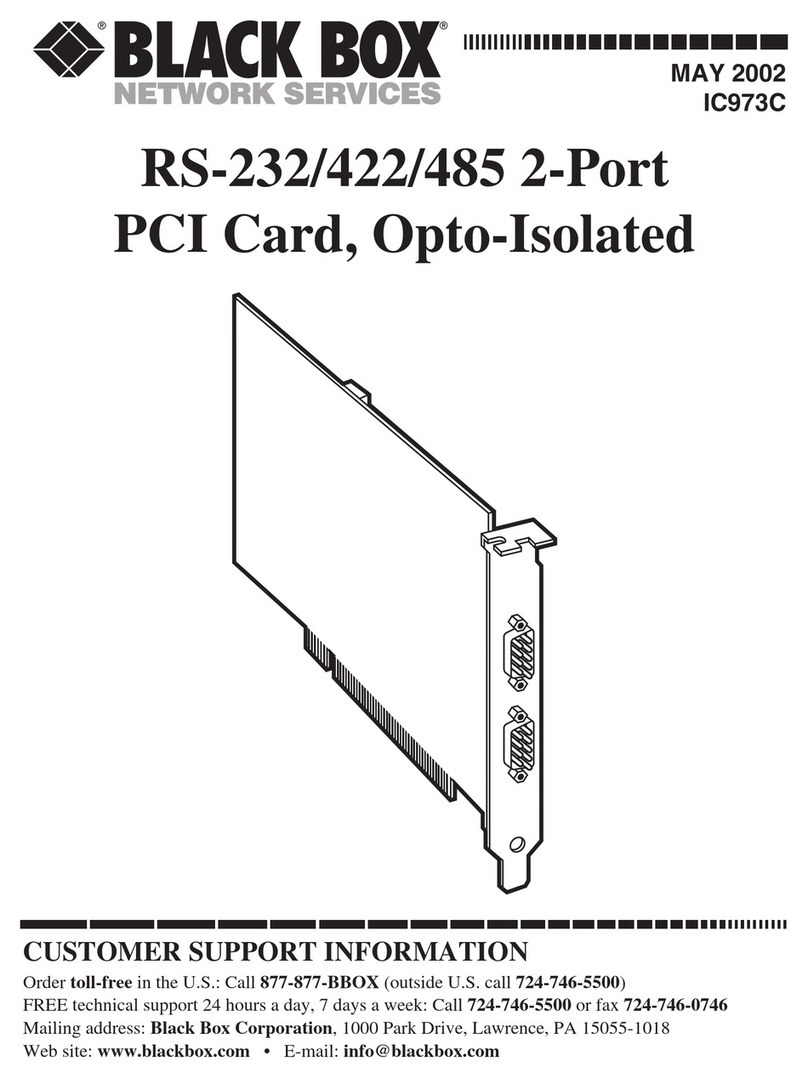
Black Box
Black Box USB Director RS-232 User manual
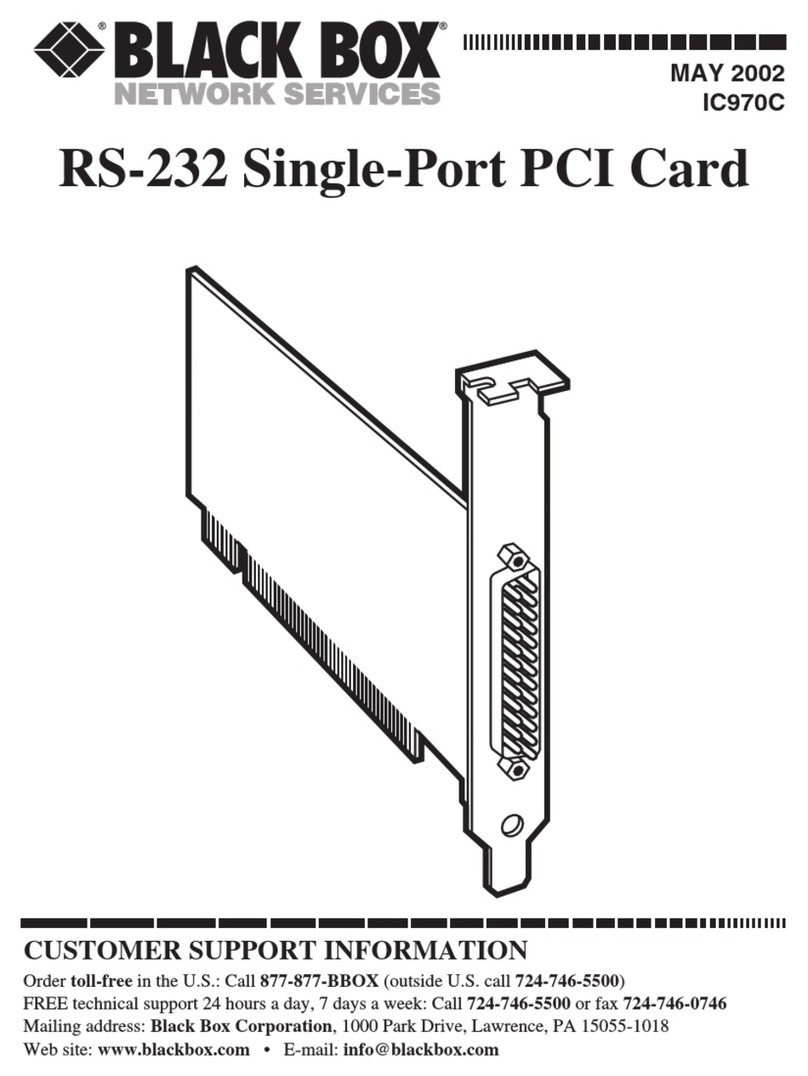
Black Box
Black Box IC970C User manual

Black Box
Black Box IC126C User manual

Black Box
Black Box USB Director RS-232 User manual
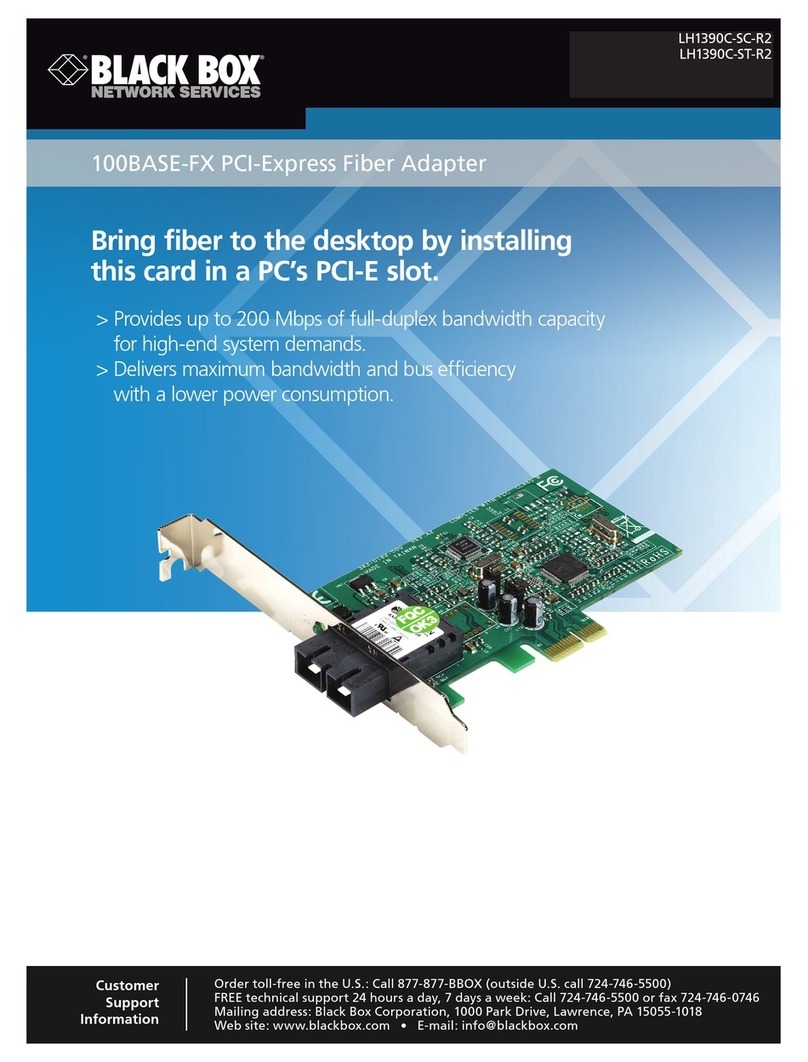
Black Box
Black Box LH1390C-SC-R2 User manual
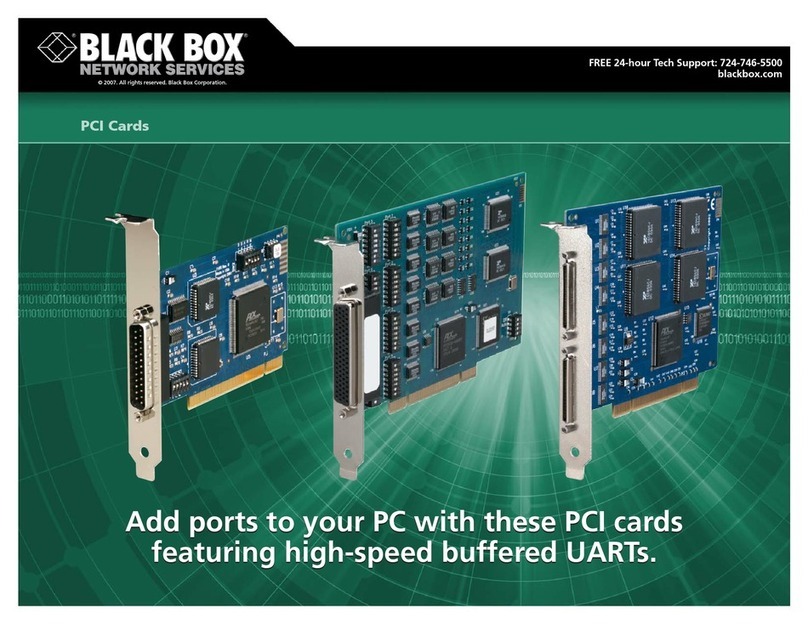
Black Box
Black Box IC142C User manual
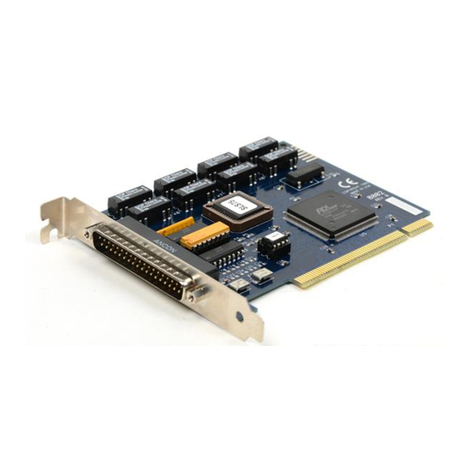
Black Box
Black Box IC904C User manual
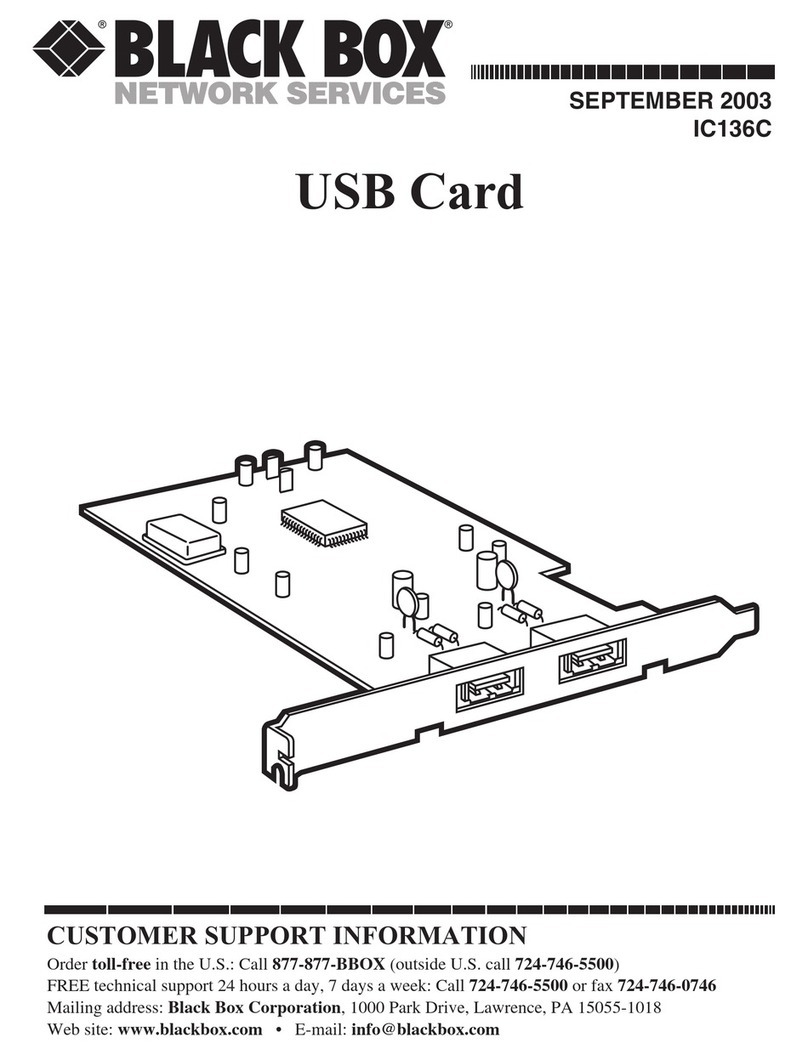
Black Box
Black Box IC136C User manual
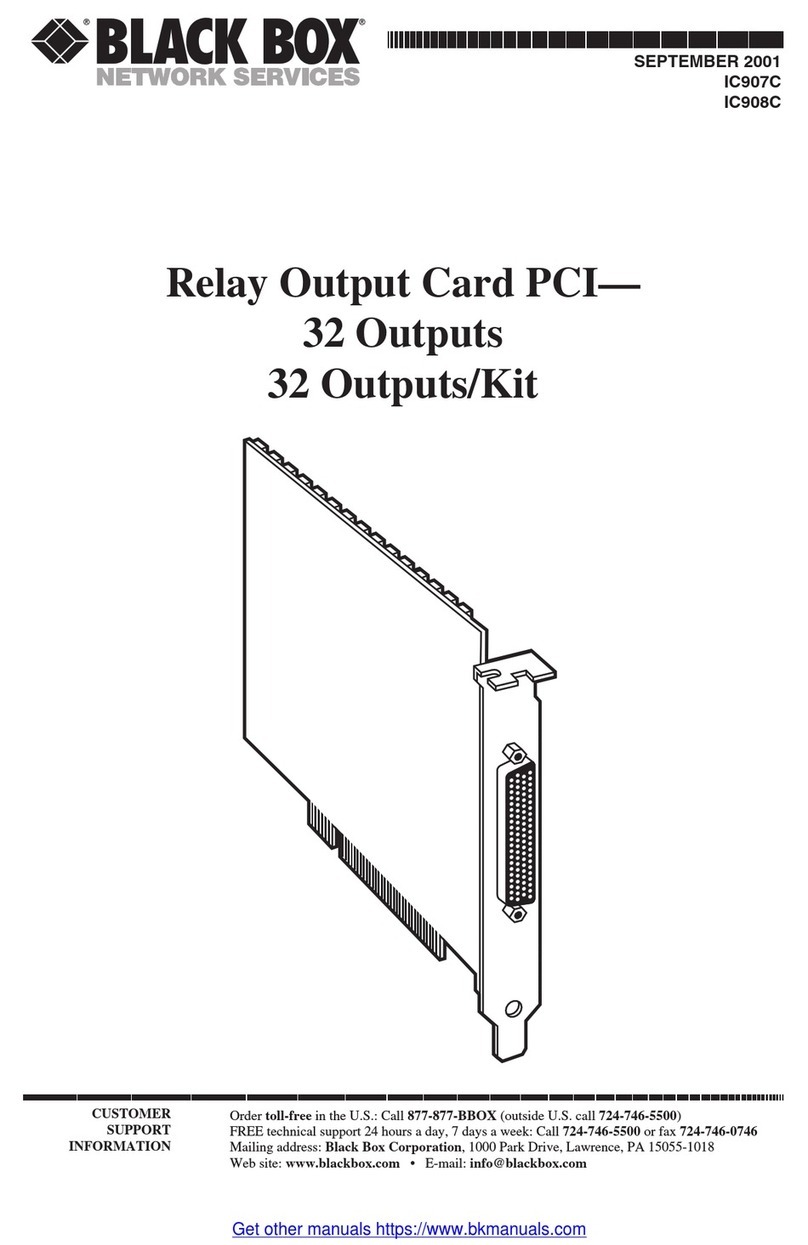
Black Box
Black Box IC907C User manual

Black Box
Black Box USB Director RS-232 User manual


